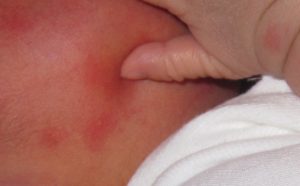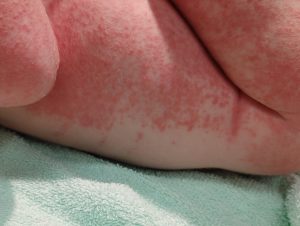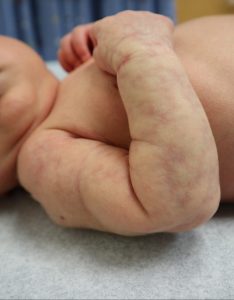Chapter 2: Rashes of the Newborn
Benign Skin Changes of the Newborn
Erythema Toxicum Neonatorum
Erythema Toxicum Neonatorum (ETN) is a common benign skin disorder that occurs in nearly half of full-term neonates and usually appears in the first 3 days of life. It is less common in premature infants.
ETN is usually not present at birth, but begins between 1-2 days of life. It presents with tiny papules, pustules or vesicles (1-2mm) with a blush of redness around them. They distributed mostly on the trunk, occasionally involving the face, buttocks and extremities. The palms and soles are almost never affected.
No management is required, as the rash is asymptomatic and resolves spontaneously. Alternate diagnoses should be considered if the rash is present immediately from birth, does not resolve with the expected time course, or the neonate is systemically unwell.

Transient Neonatal Pustular Melanosis
Transient neonatal pustular melanosis is usually present from birth and affects ~5% children with dark skin. It also presents with superficial pustules, however these are larger than those seen in ETN. When they resolve, they leave behind a collarette of scale and characteristic brown spots. As with ETN, it is a benign and self-resolving.
Neonatal Cephalic Pustulosis
Neonatal cephalic pustulosis, more commonly known as neonatal acne, is a pustular rash that usually starts between 2-3 weeks of life and resolves by ~3 months. It is distributed on the face but does not have comedones (“blackheads” and “whiteheads”) like typical acne. It is thought caused by a reaction to Malassezia yeast. As the rash is self-limited, treatment is usually unnecessary.
Infantile Acne
Infantile acne is a form of acne that occurs slightly later than this (between 2-12 months of age) and differs in that there are frequently comedones in addition to pustules. It can result in scarring so treatments similar to those for adolescent acne are recommended (similar approach to adolescent acne). If severe, evaluation for precocious puberty is recommended.

Neonatal Candidiasis
Neonatal candidiasis is a yeast infection of the skin acquired during or shortly after delivery. It usually presents around 1 week of age and affects the diaper area, but may also be seen in body folds and on the face. It consists of red patches with satellite papules and pustules. Topical antifungals are usually sufficient. Less commonly, the infection is acquired in utero and is present at birth (congenital candidiasis). This rash is more widespread and premature or unwell neonates may require IV antifungals due to a risk of systemic infection.

Miliaria
Miliaria affects ~15% of newborns. It occurs due to obstruction of sweat ducts and may present as small “dew drop-like” vesicles, pustules or red bumps depending on the depth of blockage. It commonly occurs on the head, neck and upper trunk and may follow occlusion and/or sweating (such as excess warming in an incubator or tight swaddling). It resolves without treatment.
Cutis Marmorata
Cutis marmorata is a normal physiologic skin change seen in ~50% of newborns, and occasionally lasting until later in life. It is caused by changes in the tone of superficial vessels in response to the ambient temperature. It presents with a mottled (lacy or net-like) blue to red discolouration that occurs when the body is exposed to cold temperatures. The rash usually fades away when the body is rewarmed. It is important to distinguish it from cutis marmorata telangiectatica congenita (CMTC), a vascular anomaly. CMTC differs from cutis marmorata in that it does not typically fade with rewarming, may be localized and may have atrophy of the affected area.

– Image credit to Dr. Joseph Lam

